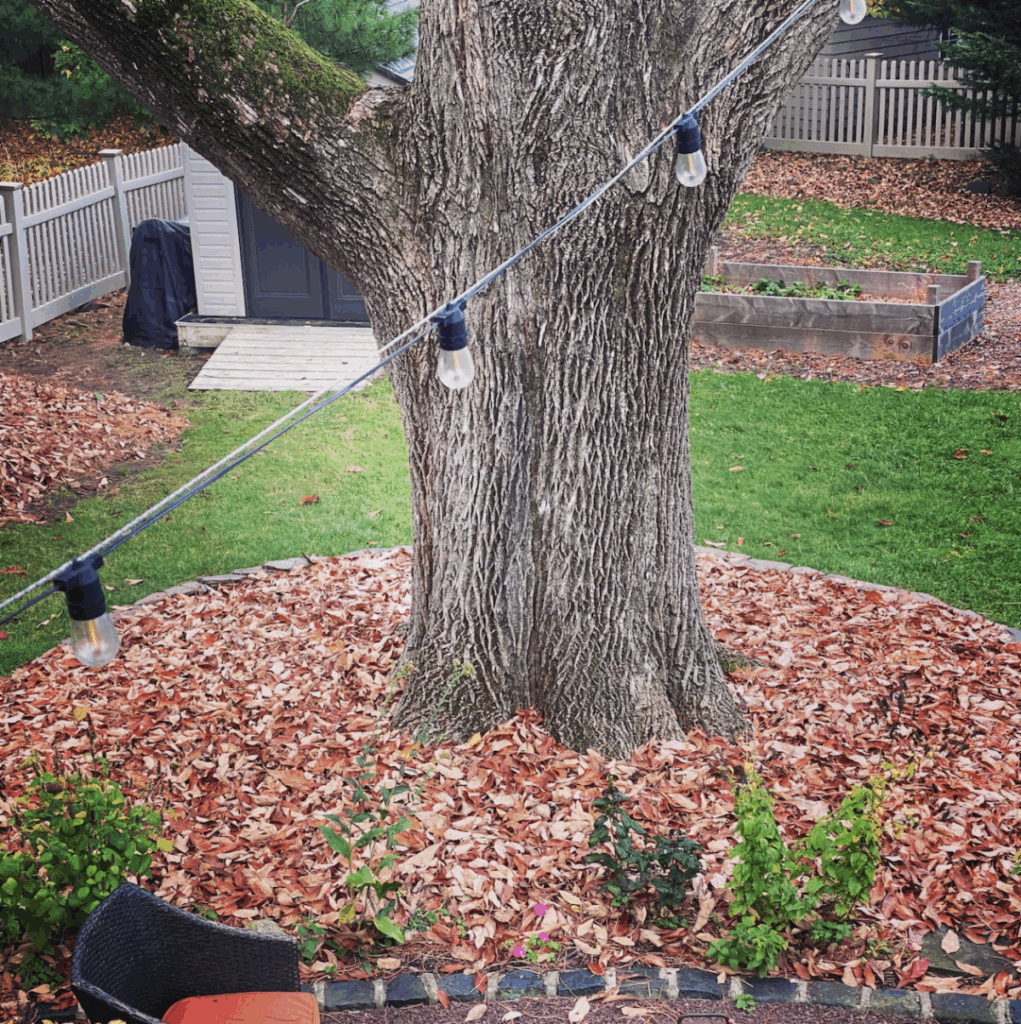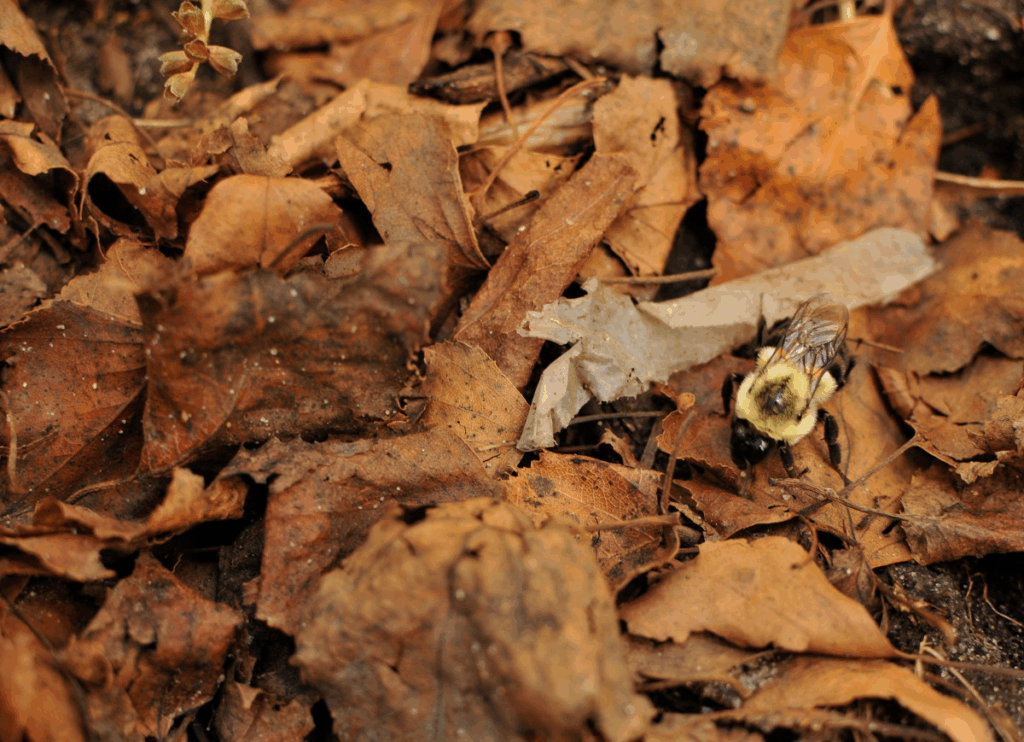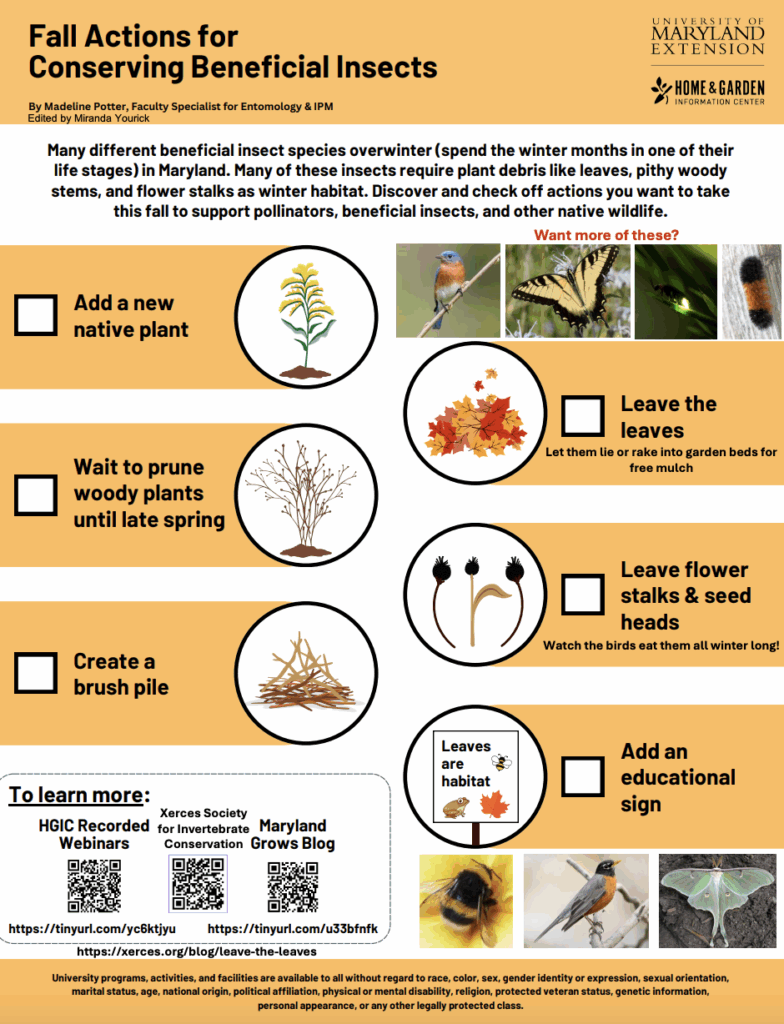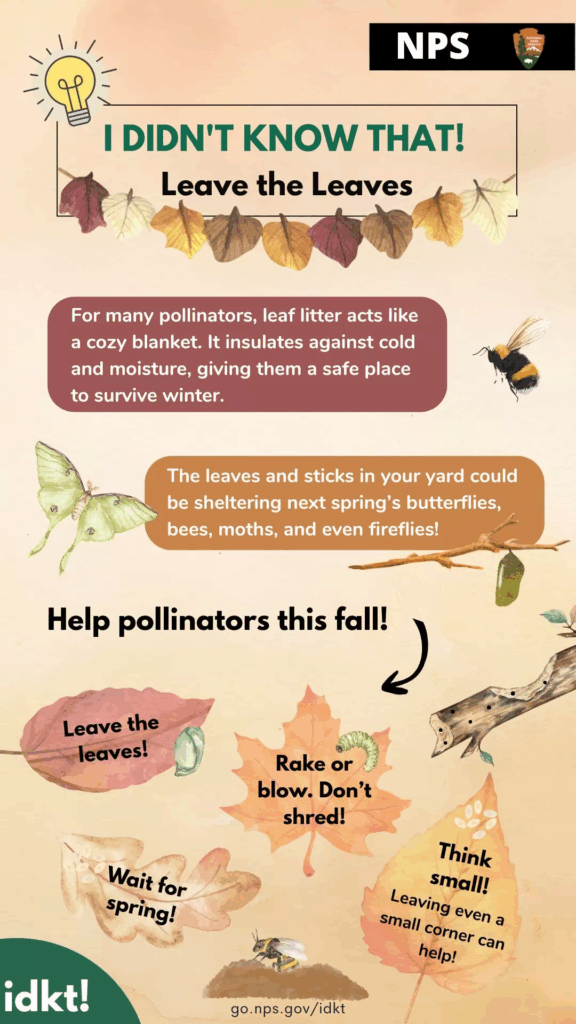October is a perfect time to adopt some wildlife-friendly fall gardening practices. While its common practice to bag leaves as “yard waste” and send them to landfills, it’s actually incredibly valuable habitat for wildlife and nutrients for plants. Making the shift to use your fallen leaves in your garden rather than throwing them out can be a simple change with lots of benefits.
Leave and Let Leave
Raking leaves: that dreaded and familiar fall task. You’ve been told that raking the fallen leaves, bagging them, and putting them on the curb is the only way to deal. What if I told you there was a much easier way?
Just leave them! A light scattering of leaves on your turf grass will not smother it.
What if I have A LOT of leaves & don’t want my grass to be covered? No worries! Simply rake or blow the leaves into your garden beds for a stellar free mulch (that can go on top of existing mulch!). Natural spaces rely on leaves to replenish nutrients and your gardens will benefit. Pile up any extra leaves to make leaf compost!

Why should we leave the leaves?
- Wildlife like bees, butterflies, moths, fireflies, and salamanders need the leaves to overwinter.
- Leaves are great habitat for bugs, which feed songbirds.
- Leaves recharge the soil with nutrients for healthier plants.
- As a mulch, leaves are great for weed suppression and moisture retention.
By bagging your leaves, you send about half of your springtime butterflies to the landfill.
Become the local hero for wildlife by leaving the leaves. So if you’re dreading the fall clean-up, just do less!!
Leave and Let Leaves written by Miranda Yourick in Friends of Anne Arundel County Trails Trail Talk, Editor’s Corner, Issue 170, October 2025. Miranda is a member and Officer of Wild Ones Chesapeake Bay.
October is Leave the Leaves Month – Join the Movement
The Xerces Society for Invertebrate Conservation
Over the last few years, gardening trends have shifted from the traditional clean and tidy to practices that are more natural and ecologically friendly. The Xerces Society for Invertebrate Conservation began promoting Leave the Leaves in their 2018 blog Where Do Pollinators Go in the Winter? The blog includes a photo “of a bumble bee queen burrowing under fallen leaves. Many bees and other invertebrate species rely on leaf litter for shelter during the winter.” (Photo: Steven Severinghaus / Flickr Creative Commons 2.0)

“Yes, we probably sound like a broken record by now, but leaves and other “litter” are essential shelter for hibernating bumble bee queens and the larvae of numerous butterfly and moth species. Many of these species will happily tuck into a leaf or mulch pile, so you likely already have some nearby! For more information on why this so important, see our previous blog posts about the Leave the Leaves campaign and Fall Garden Tips to Benefit Bumble Bees All Year. As an added bonus, leaf and mulch piles will also attract beneficial insects like lady beetles, so they’ll already be perfectly situated to attack aphids in your garden when spring arrives!”
Xerces offers numerous articles, publications, videos, and podcasts that promote ecologically friendly garden practices, including Leave the Leaves to Benefit Wildlife and Leave the Leaves: Winter Habitat Protection (be sure to check out the additional resources at the bottom of the pages). And check out their YouTube channel for an extensive library of videos and podcasts, including their most recent episode of Bug Banter, Leave the Leaves or Lose the Insects, from September 2, 2025.
The National Wildlife Foundation
n 2023, the inaugural Leave the Leaves Report celebrated the start of the National Wildlife Federation’s National Leave the Leaves Month in October by surveying nearly 1,200 people to better understand behaviors and sentiments toward Autumn leaves. WeatherNation spoke with the National Wildlife Federation to learn more about the month:
Read more information from NWF on How to Leave the Leaves. And watch the short video below.
But Wait….There’s More!
The University of Maryland Extension
If you’re interested in education material for outreach tables, check out Life Amongst The Leaves Educational Display created by Madeline E. Potter, Faculty Specialist for Entomology and Integrated Pest Management University of Maryland Extension, along with her Fall Actions for Conserving Beneficial Insects below.

To learn more about creating overwintering habitats in your greenspaces, check the UME webinar below on To Rake or Not to Rake, or one of their many Maryland Grows Blog posts about supporting pollinators in the fall and winter.
Maryland Department of Natural Resources
A recently published research study, featuring Max Ferlauto, calculates just what the impacts of leaf removal are to which organisms and also offers insights into how and where in our landscapes we can leave the leaves to create habitat with the most positive impact. Max Ferlauto, the Maryland state entomologist, is one of the scientists who conducted the new research, and in March this year, Max and Karin Burghardt, an ecologist and associate professor at the University of Maryland-College Park, published research on the impacts of leaf removal resulting from their two-year study in 20 residential suburban Maryland yards. In the Impacts of Leaf Removal podcast, Margaret Roach of “A Way to Garden” talked about the takeaways of the study, and how the data can help inform gardeners seeking to develop their own more ecological fall cleanup plans.
The National Park Service
“Did you learn something new? Pass it on! Protecting our ecosystems is a job for us all, but there’s no way for everyone to be an expert in everything. That’s why sharing knowledge is so important! So next time you see a neighbor raking up their leaves, let them know that leaving the leaves can help the pollinators in their own backyard!” (Source: The National Park Service, I Didn’t Know That!: Leave the Leaves)
Download or screenshot their card to share with a friend or help you remember to leave the leaves. Thank you for helping protect pollinators!

